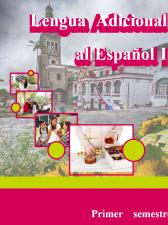Practica esta lección:
Ir al examen
70
What I do and how I live
B
lock
II
What do you know? (Previous knowledge and
competencies)
A verb is often de
¿
ned as a word which shows action or state of being. The verb
is the
heart
of the sentence. One of the most important things about verbs is their
relationship to time.
Un verbo se de
¿
ne como la palabra que muestra acciones o estados del ser. El verbo es el corazón de la
oración. Uno de los puntos más importantes del verbo es su relación con el tiempo.
A. Look at the words in the following box and underline the verbs.
Observa las palabras del siguiente cuadro y subraya los verbos.
work
table
brother
play
wear
breakfast
dog
sleep
speak
school
friend
read
Check your answers in the Answer Key at the end of the book.
Revisa tus respuestas en la Clave de Respuestas al
¿
nal del libro.
B. Look at the pictures and try to describe each one of them. What kind of actions do
you see in the images? Share your answer with a classmate.
Observa las imágenes y trata de describir cada una. ¿Qué tipo de acciones ves? Comenta tu respuesta con un
compañero.
C. For describing actions happening now, we use the simple present of a verb.
Read the following sentences and look how the verbs are formed and used. Pay
attention to the changes that occur at the end of the verb.
Para describir las acciones que suceden ahora, se utiliza el tiempo presente de un verbo. Lee el siguiente texto
y observa cómo se forman y usan los verbos.
Pon atención en los cambios que ocurren al
¿
nal de los verbos.
Miguel is a taxi driver. He drives a taxi. But on Sundays, he doesn’t drive his taxi. He stays at
home.
Clara is a teacher. She works in a small school and she loves her students.
The verbs be, drive, stay, work and love are in the simple present.
